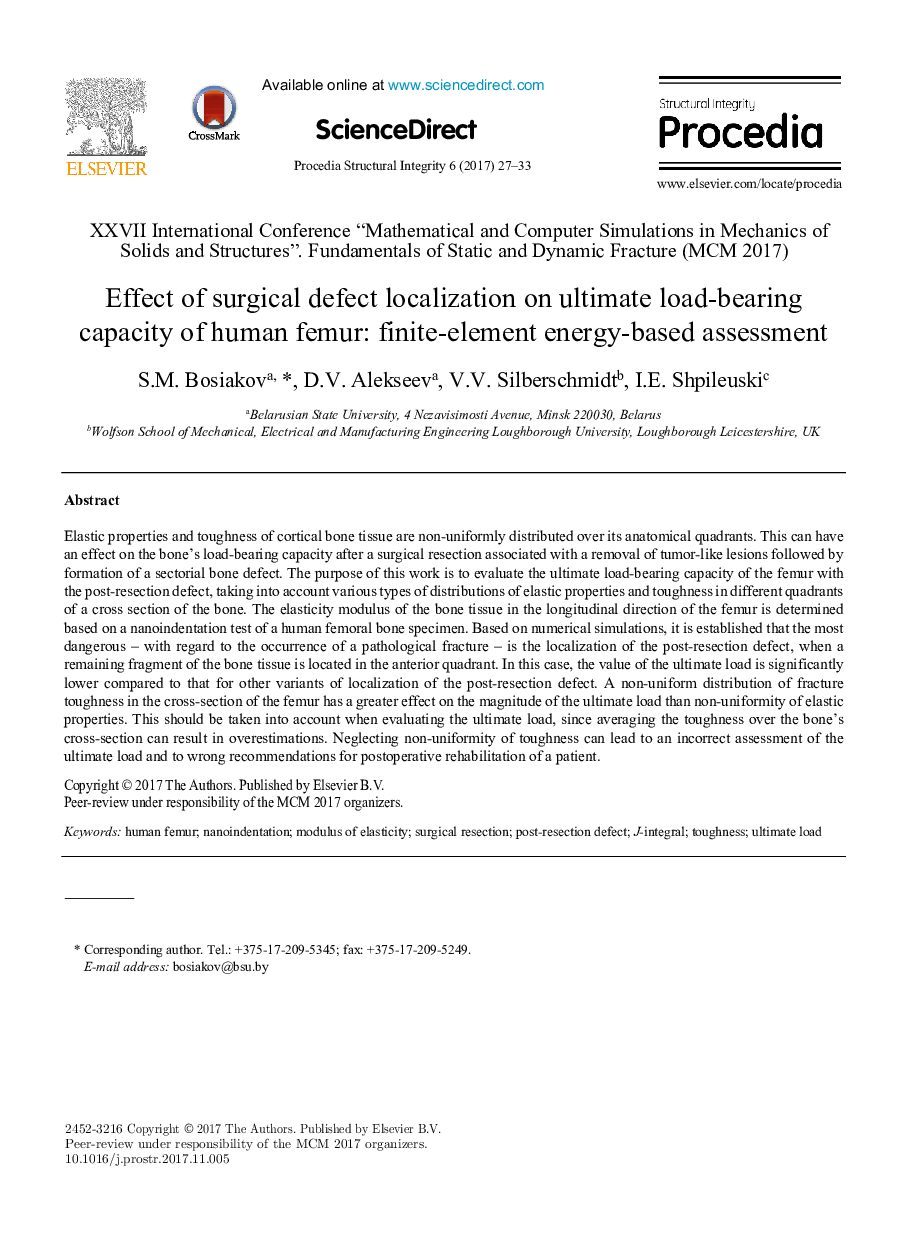| کد مقاله | کد نشریه | سال انتشار | مقاله انگلیسی | نسخه تمام متن |
|---|---|---|---|---|
| 7954989 | 1513781 | 2017 | 7 صفحه PDF | دانلود رایگان |
عنوان انگلیسی مقاله ISI
Effect of surgical defect localization on ultimate load-bearing capacity of human femur: finite-element energy-based assessment
ترجمه فارسی عنوان
اثر جابجایی نقایص جراحی بر ظرفیت نهایی بارگذاری استخوان انسانی: ارزیابی مبتنی بر انرژی پایه
دانلود مقاله + سفارش ترجمه
دانلود مقاله ISI انگلیسی
رایگان برای ایرانیان
کلمات کلیدی
ترجمه چکیده
خواص الاستیک و سختی بافت استخوان کورتیک به طور غیرمستقیم بر روی چهار قطعه آناتومیک توزیع می شود. این می تواند بر ظرفیت تحمل استخوان پس از برداشت جراحی همراه با حذف ضایعات تومور مانند پس از تشکیل یک نقص استخوان بخش. هدف از این کار ارزیابی ظرفیت نهایی تحمل استخوان فمور با نقص پس از رزکسیون است که با در نظر گرفتن انواع مختلف توزیع خواص کششی و چقرمگی در کادرهای مختلف مقطع استخوان. مدول الاستیسیته بافت استخوانی در جهت طولی استخوان فمور بر اساس یک آزمون نانو انداختن نمونه استخوانی فمورال انسان تعیین شده است. بر اساس شبیه سازی های عددی، مشخص شده است که با توجه به وقوع یک شکستگی پاتولوژیک، خطرناک ترین نقص پس از رزکسسیون است، زمانی که بخش باقیمانده بافت استخوانی در ربع قدامی قرار دارد. در این حالت، مقدار بار نهایی نسبت به سایر روشهای موضع گیری نقص پس از رزکسینسیون نسبتا پایین است. توزیع غیر یکنواختی چقرمگی شکست در قسمت مقطع فمور تاثیر بیشتری بر مقدار بار نهایی نسبت به عدم تناسب خواص کششی دارد. این در هنگام ارزیابی بار نهایی باید در نظر گرفته شود، زیرا میانگین نفوذپذیری بر روی مقطع استخوان ممکن است منجر به برآوردی شود. نادیده گرفتن عدم تناسب سختی می تواند منجر به ارزیابی اشتباه از بار نهایی و توصیه های غلط برای توانبخشی پس از عمل بیمار شود.
موضوعات مرتبط
مهندسی و علوم پایه
مهندسی مواد
شیمی مواد
چکیده انگلیسی
Elastic properties and toughness of cortical bone tissue are non-uniformly distributed over its anatomical quadrants. This can have an effect on the bone's load-bearing capacity after a surgical resection associated with a removal of tumor-like lesions followed by formation of a sectorial bone defect. The purpose of this work is to evaluate the ultimate load-bearing capacity of the femur with the post-resection defect, taking into account various types of distributions of elastic properties and toughness in different quadrants of a cross section of the bone. The elasticity modulus of the bone tissue in the longitudinal direction of the femur is determined based on a nanoindentation test of a human femoral bone specimen. Based on numerical simulations, it is established that the most dangerous - with regard to the occurrence of a pathological fracture - is the localization of the post-resection defect, when a remaining fragment of the bone tissue is located in the anterior quadrant. In this case, the value of the ultimate load is significantly lower compared to that for other variants of localization of the post-resection defect. A non-uniform distribution of fracture toughness in the cross-section of the femur has a greater effect on the magnitude of the ultimate load than non-uniformity of elastic properties. This should be taken into account when evaluating the ultimate load, since averaging the toughness over the bone's cross-section can result in overestimations. Neglecting non-uniformity of toughness can lead to an incorrect assessment of the ultimate load and to wrong recommendations for postoperative rehabilitation of a patient.
ناشر
Database: Elsevier - ScienceDirect (ساینس دایرکت)
Journal: Procedia Structural Integrity - Volume 6, 2017, Pages 27-33
Journal: Procedia Structural Integrity - Volume 6, 2017, Pages 27-33
نویسندگان
S.M. Bosiakov, D.V. Alekseev, V.V. Silberschmidt, I.E. Shpileuski,
